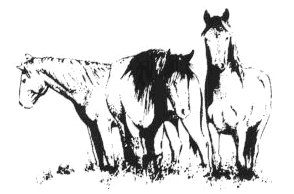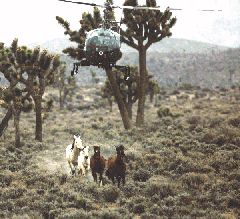|
Note: This document is an exact reproduction of the BLM's formal response to Associated Press reports of "widespread abuse" of adopted BLM horses, including charges that large numbers of wild horses were being diverted to slaughterhouses by profiteers. It is presented on this website in an effort to present the various views and positions regarding this sensitive issue. An investigation by Bureau of Land Management law enforcement officers contradicts recent press allegations that wild horses are routinely sent to slaughter. The investigation, prompted by an Associated Press story (January, 1997) claiming that wild horses were being "channeled by the thousands to slaughterhouses," found that less than one-quarter of one percent of all horses sent to meat-packing plants were ever wild, Federally protected or managed by the agency. In the course of the investigation, the BLM sent teams of law enforcement agents and wild horse experts to eight horse slaughterhouses in the U.S. and one in Canada. With the cooperation and assistance of meat processing plant owners and managers, these teams reviewed data from the last two years. They found that about 266,000 horses were slaughtered during 1995 and 1996 and that less than one quarter of one percent, about 350 per year, were at any time wild. In contrast, the wild horse adoption program, which is conducted by the BLM, adopts out about 8,000 horses each year to qualified adopters. "While any wild horse being sent to slaughter is regrettable, it is obvious that this is occurring to a far, far lesser degree than was alleged" said Interior Department Assistant Secretary Bob Armstrong, who ordered the investigation. "In spite of that, I have asked the BLM to continue their top-to-bottom review of the program to ensure that opportunities for abuse are eliminated." Associated Press reports also alleged that BLM employees were "...among those profiting from the slaughter." Slaughterhouse records reviewed by BLM investigators also contradict this allegation. They revealed that only one BLM employee in the last two years has sold a horse that ultimately went to slaughter. In that particular case, there was no evidence profiteering or illegal or unethical behavior on the part of the employee. The horse in question had been titled, became private property and was sold to a second owner. "The reports of employees profiting from sending wild horses to slaughter were particularly distressing," BLM Interim Director Sylvia Baca said. "We owe it to taxpayers and to our employees to look at those claims seriously. Our employees who adopt wild horses and burros do so because they love the animals, and I can say with confidence that they represent some of our very best adopters." According to Baca, the adoption process requires a careful pre-screening of applicants, a mandatory briefing prior to adoption on care requirements of horses and the signing of a care agreement by the prospective adopter. Further, applicants are cautioned that the adopted horse remains federal property at least until one year of proper care has been provided and BLM has transferred title to the adopter and that during the time, unannounced spot checks of the horses may be made by federal officials. In 1996, BLM conducted almost 3,000 such spot checks and responded to over 200 horse neglect complaints which led to the repossess ion of 51 horses and the reassignment of 317 horses to other adopters. As part of its continuing efforts to improve the horse adoption program, the BLM recently announced that it will begin offering some adoptable horses on a competitive bidding basis. This action is expected to result in higher adoption fees for some animals, which will help defray expenses for the program. Higher adopter investment costs should also further diminish what minimal profiteering incentives may exist for adopting horses and sending them to slaughter after titling.
Baca pointed out that the BLM invests almost $1,100 in getting each horse ready for adoption, including substantial costs in direct horse care. Horses gathered from the rangeland are immediately provided with abundant food as well as water, given a veterinary check, provided with appropriate medication and de-wormed. Additionally, in response to severe drought conditions in parts of the west, BLM convened a team of horse experts that, in consultation with a variety of horse interest groups and humane groups, has provided more than 20 recommendations relating to the emergency drought situation and the long-range direction of the horse program. The recommendations include changes in the oversight and management of the program, changes in the wild horse and burro strategic plan, and the reestablishment of a national wild horse and burro advisory board. As part of the continuing efforts to improve the program, Baca also directed the creation in January of a review team to provide recommendations on a variety of other wild horse and burro program issues, including employee adoptions, the spot check or compliance process, the horse and burro data base, and the horse and burro titling process. A report from that team is expected in March. Baca stated, "I am committed to looking into every specific complaint or allegation of wrong doing. If there are problems in this program, we want to find them and fix them." The wild horse and burro program was established following the passage of the Wild, Free Roaming Horse and Burro Act of 1971. The Act charged the BLM with managing wild horse herds in 10 western states. To ensure the long-term survivability of the herds, which have few natural predators and reproduce at a rate as high as 20 percent per year, the BLM gathers what are considered to be excess animals and makes them available for adoption at a fee of $125. Currently there are 42,000 wild horses and burros on the public rangelands. Read the Original AP ArticleBarbara Eustis-Cross' ResponseThis is not a BLM operated or BLM
sponsored site. It is run by private wild horse and burro
enthusiasts. We are thankful to the BLM for providing the
information which is presented in this document.
Return to KBR Wild Horse and Burro NewsReturn to KBR World of Wild Horses & BurrosGo to other Wild Horse LinksGo To
|

 "The taxpaying public is getting a lot for its money on this
program," Baca said. "Congress has mandated that we protect and
manage these animals, as well as the land where they still roam.
The annual $16 million we spend each year has resulted in tens of
thousands of horses living better lives with good, caring
families. Further, by removing excess horses and burros, we have
been able to improve the health of fragile western rangeland
that ranching families and wildlife depend on. This helps provide
better habitat for a variety of wildlife such as deer, elk and
antelope." Baca said.
"The taxpaying public is getting a lot for its money on this
program," Baca said. "Congress has mandated that we protect and
manage these animals, as well as the land where they still roam.
The annual $16 million we spend each year has resulted in tens of
thousands of horses living better lives with good, caring
families. Further, by removing excess horses and burros, we have
been able to improve the health of fragile western rangeland
that ranching families and wildlife depend on. This helps provide
better habitat for a variety of wildlife such as deer, elk and
antelope." Baca said.